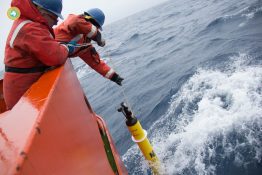Less than three months into its mission, NASA’s Ice, Cloud and land Elevation Satellite-2, or ICESat-2, is already exceeding scientists’ expectations. The satellite is measuring the height of sea ice to within an inch, tracing the terrain of previously unmapped Antarctic valleys and measuring other interesting features in our planet’s elevation. Benjamin Smith, a glaciologist with the University of Washington and member of the ICESat-2 science team, shared the first look at the satellite’s performance at the American Geophysical Union’s annual meeting Dec.
Read more at UW Today »Polar bears gorged on whale carcasses to survive past warm periods, but strategy won't suffice as climate warms
Polar bears likely survived past warm periods in the Arctic, when sea ice cover was low, by scavenging on the carcasses of stranded large whales. This food source sustained the bears when they were largely restricted to land, unable to roam the ice in search of seals to hunt. A new study led by the University of Washington found that although dead whales are still valuable sources of fat and protein for some polar bears, this resource will likely not be enough to sustain most bear populations in the future when the Arctic becomes ice-free in summers, which is likely to occur by 2040 due to climate change.
Read more at UW Today »Volcano under ice sheet suggests thickening of West Antarctic ice is short-term
A region of West Antarctica is behaving differently from most of the continent’s ice: A large patch of ice there is thickening, unlike other parts of West Antarctica that are losing ice. Whether this thickening trend will continue affects the overall amount that melting or collapsing glaciers could raise the level of the world’s oceans. A study led by the University of Washington has discovered a new clue to this region’s behavior: A volcano under the ice sheet has left an almost 6,000-year record of the glacier’s motion.
Read more at UW Today »UW professor Cecilia Bitz elected American Geophysical Union fellow
Cecilia M. Bitz, a University of Washington atmospheric scientist, has been elected as a fellow of the American Geophysical Union. The UW honoree is among 62 new 2018 fellows from 21 countries.The scientific group recognizes only one in 1,000 members each year for major scientific work and sustained impact. Bitz is a UW professor in the atmospheric sciences department and director of the Program on Climate Change.
Read more at UW Today »Diving robots find Antarctic winter seas exhale surprising amounts of carbon dioxide
More than 100 oceanic floats are now diving and drifting in the Southern Ocean around Antarctica during the peak of winter there. These instruments are gathering data from a place and season that’s poorly studied, despite its important role in regulating the global climate. A new study from the University of Washington, the Monterey Bay Aquarium Research Institute, Princeton University and several other oceanographic institutions uses data gathered by the floating drones over past winters to learn how much carbon dioxide is transferred by the surrounding seas.
Read more at UW Today »





